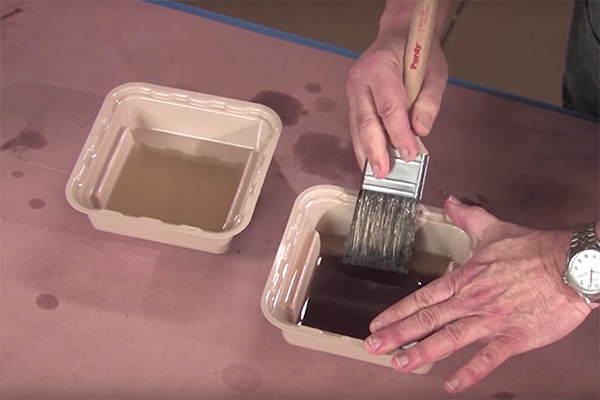
How should I clean oil stain and finish brushes? I use high quality (translation: expensive) brushes to do finish work and clean them with mineral spirits, alcohol, or turpentine, but I always end up with stiff bristles and hence a useless brush. Leaving the brush in solution remedies the problem for ‘next-day’ jobs, but over long periods between projects, I’ll lose another brush. Also, what am I to do with 3 quarts of dirty distillate? What does “dispose of properly” mean? Can I safely pour it down the sink?
John Brock: I also clean my brushes in mineral spirits, or alcohol. I have a pre-wash can (with a lid) that I use to clean off the worst of the mess. Then I’ll partially dry the brush on a rag, then clean the brush in a second can of clean solvent. When the dirty can gets too bad to use, it gets poured into another can I use for settling. I keep two of these settling cans going. After the gluck settles out, I decant the now clear solvent band into the first wash can. When the secondary wash can gets a bit grungy, it becomes a primary cleaning can. Eventually I end up with a couple of containers of pretty nasty stuff. I take these to the county transfer station on household hazardous waste days. Remember to spread out your rags on a clean concrete or the driveway to dry out. I wrap the clean brush in a wrapper of brown paper bag and secure it with a rubber band or piece of wire. To pre-condition a brush before using it, I soak it in the thinner appropriate for the finish I’m going to use. Pre-conditioning makes cleanup easier too.
Michael Dresdner: Let me add one more step to what John described, which will give you the supple results you are seeking. After washing the brush in thinner and getting it as clean as possible, squeeze out most of the excess thinner, then take the brush immediately to the sink while the bristles are still wet. Wash the brush several times with plenty of warm water and soap. Both dish soap and shampoo work well for this step. By the second or third washing, the soap will foam up readily, indicating that all the solvent, and whatever varnish residue still mixed in the solvent, are gone. Now rinse the brush several times in clean water until all the soap is out of it, spin it to shake out the excess water, and place it back in the brush keeper to reshape it while it dries. If there is no cardboard keeper, wrap the brush in brown bag paper, feel for the ends of the bristles, then fold the paper over about an inch past the ends. This will form a keeper that will allow the water to wick off while the paper “sets” the hair of the brush.
As you must have guessed by John’s comments, solvent can be strained and re-used again and again. If you get to the point that it is mostly sludge, and there is no reclamation facility nearby, simply put the sludge in a shallow pan and let the solvent evaporate. Once the sludge is completely dry, it can go in the trash, but not before. In no case should you ever pour solvents, even clean solvents, down the sink or drain. The one exception, of course, is clean alcohol.





